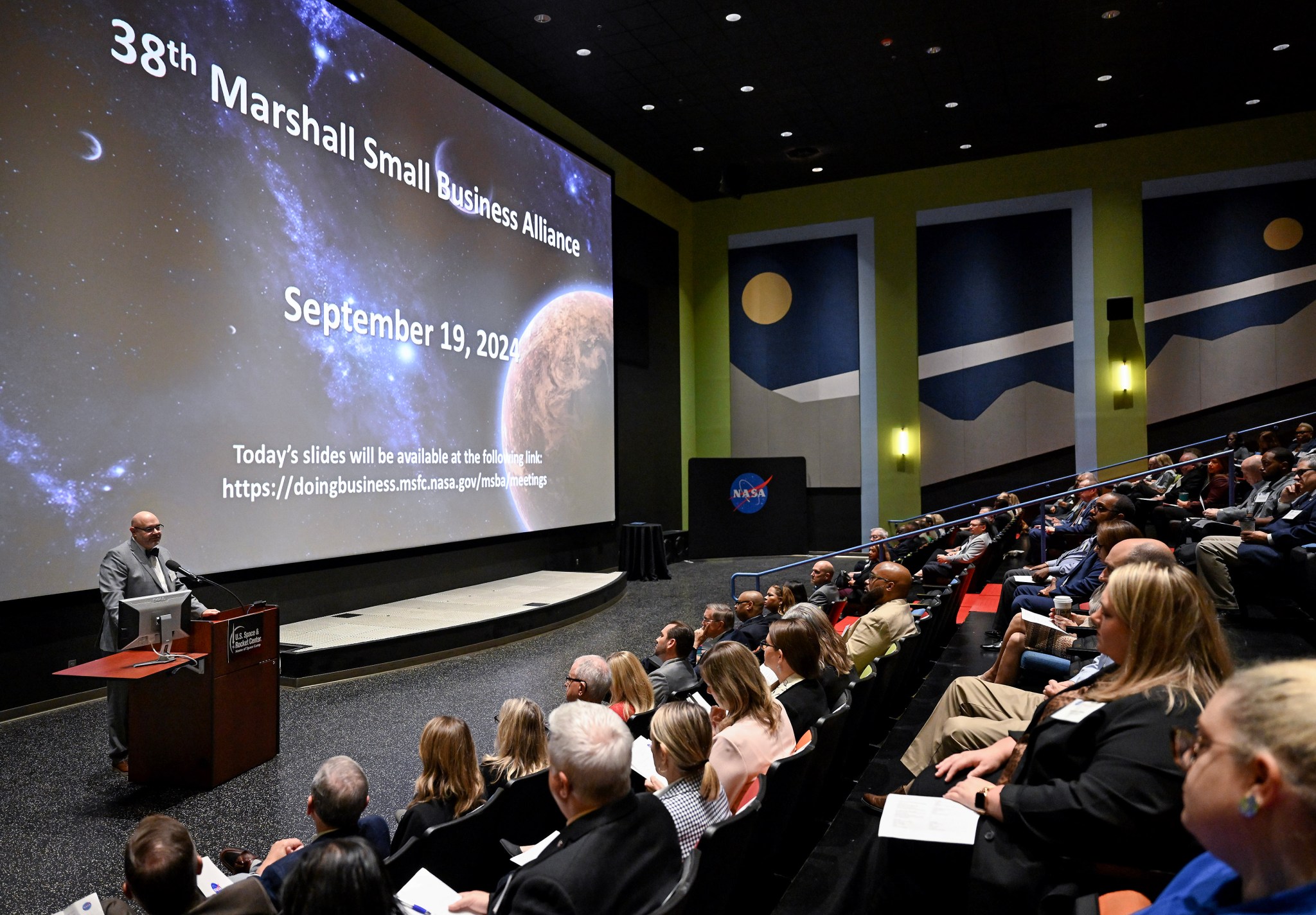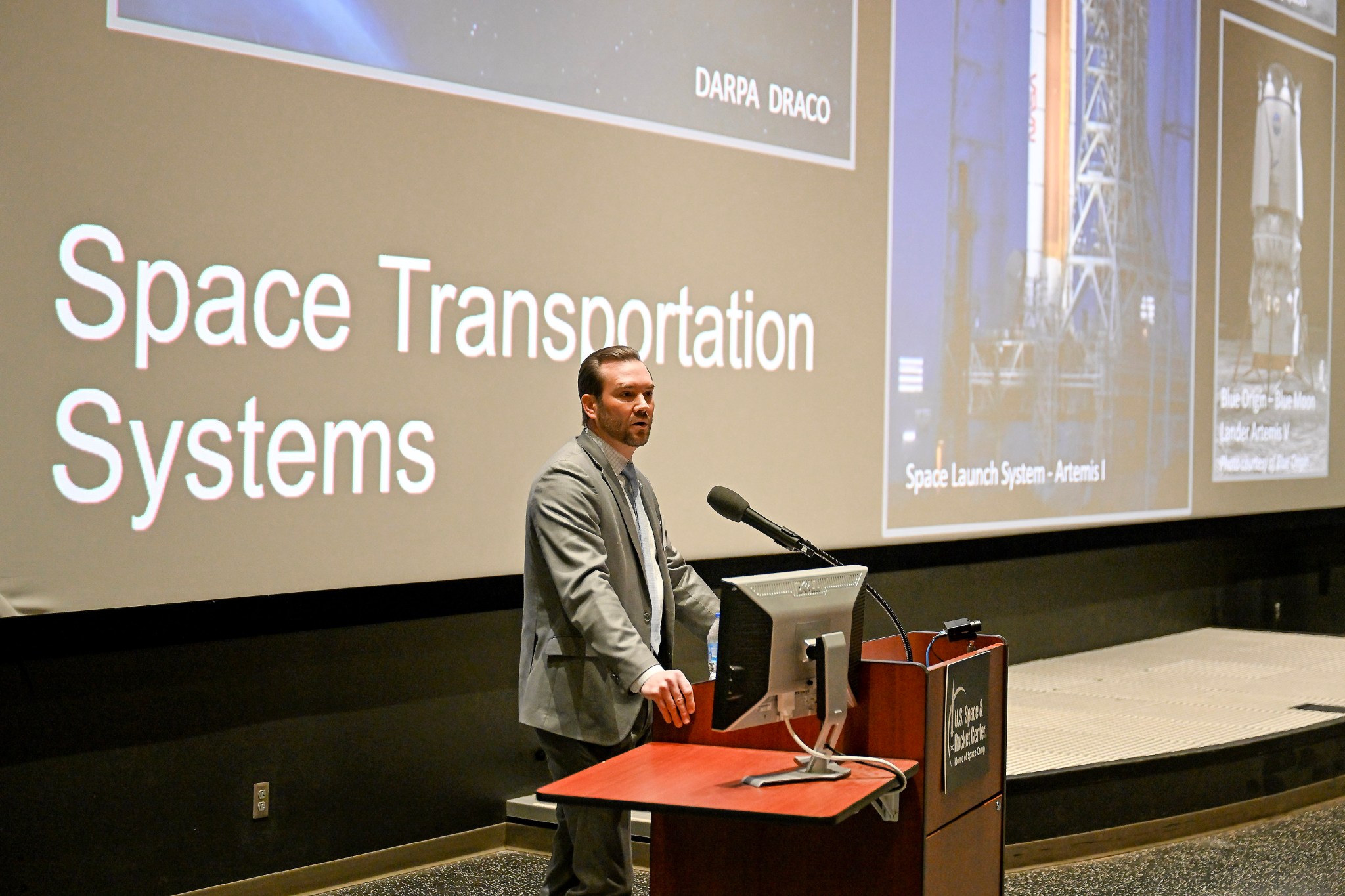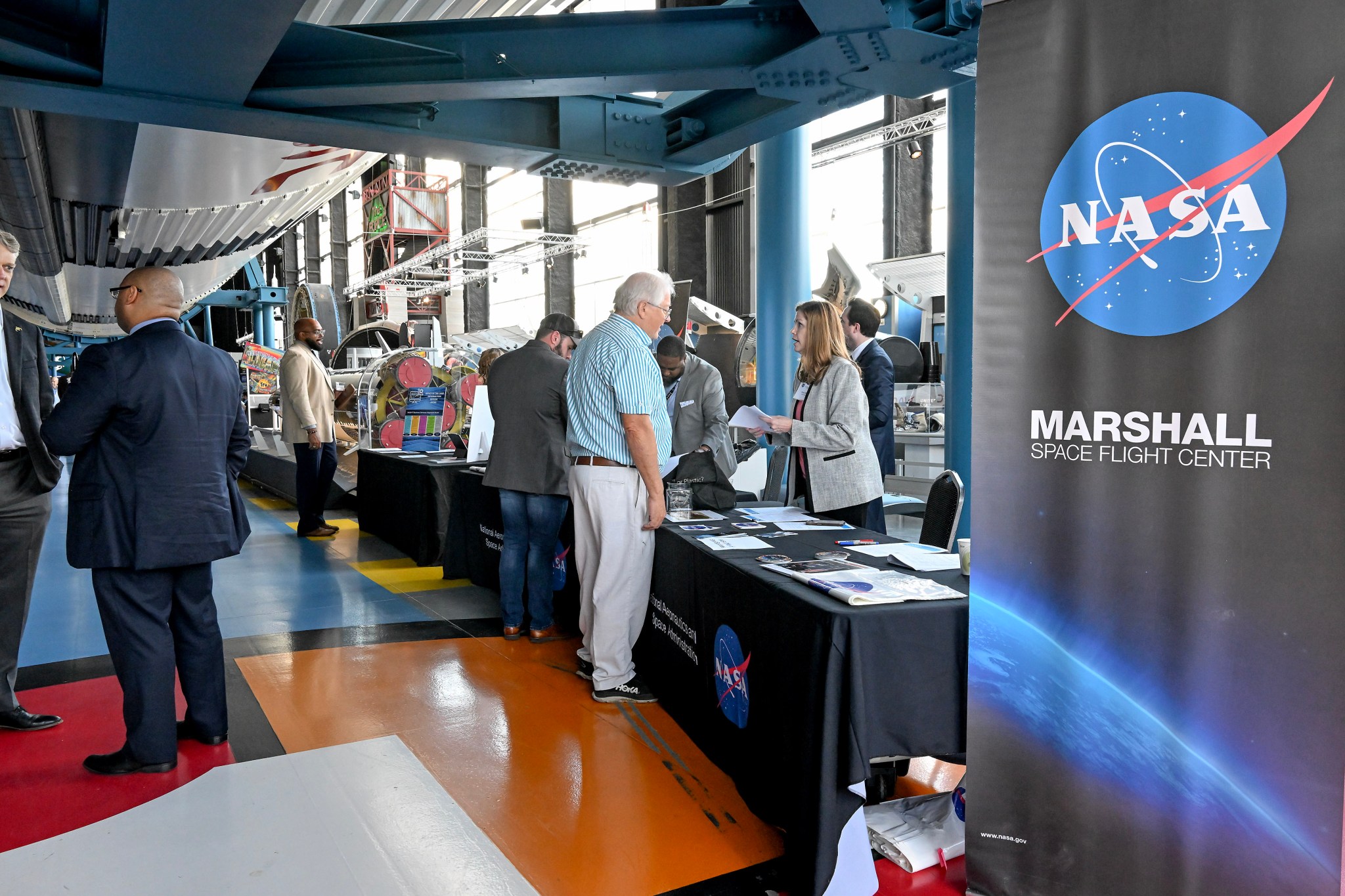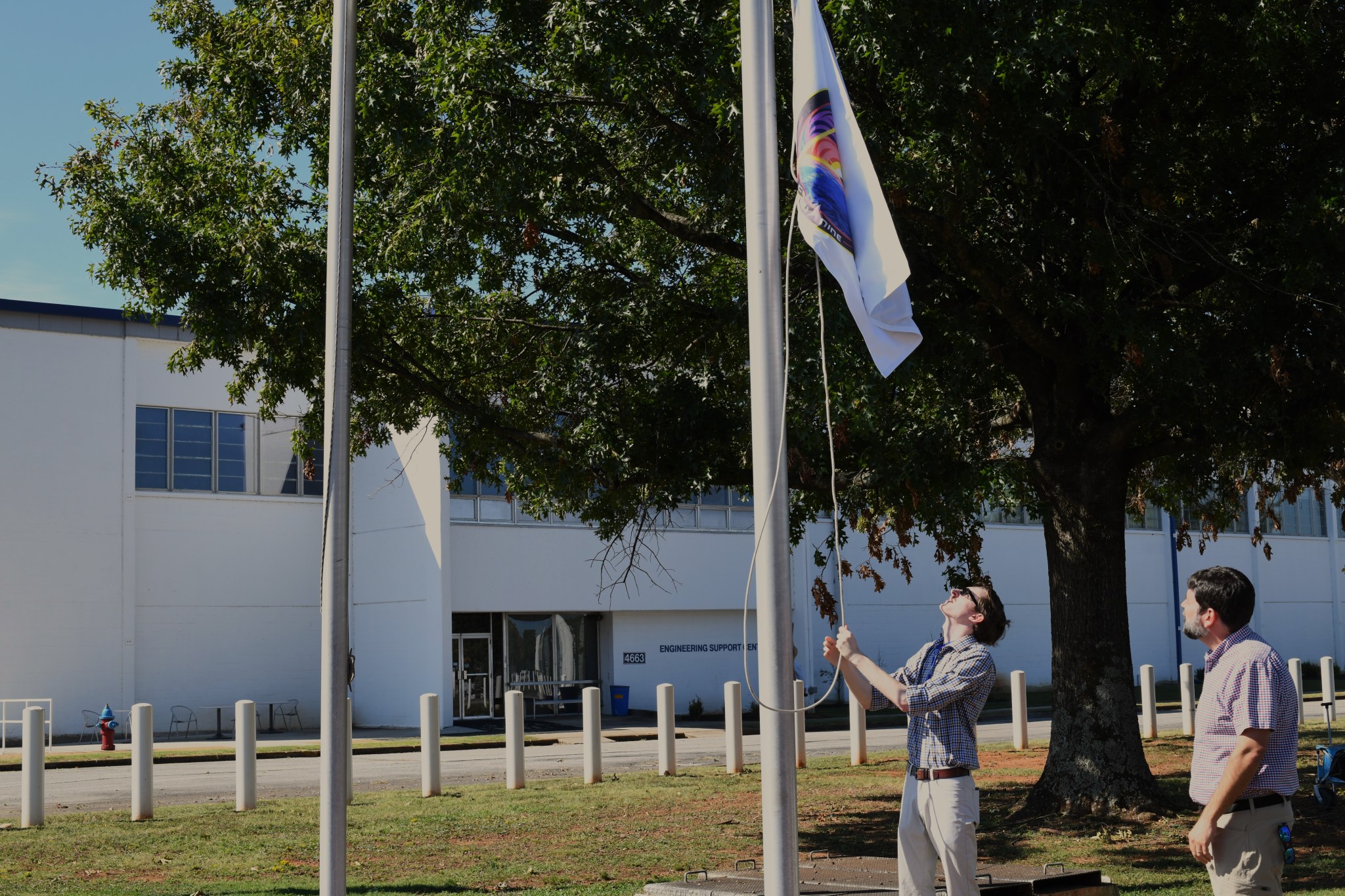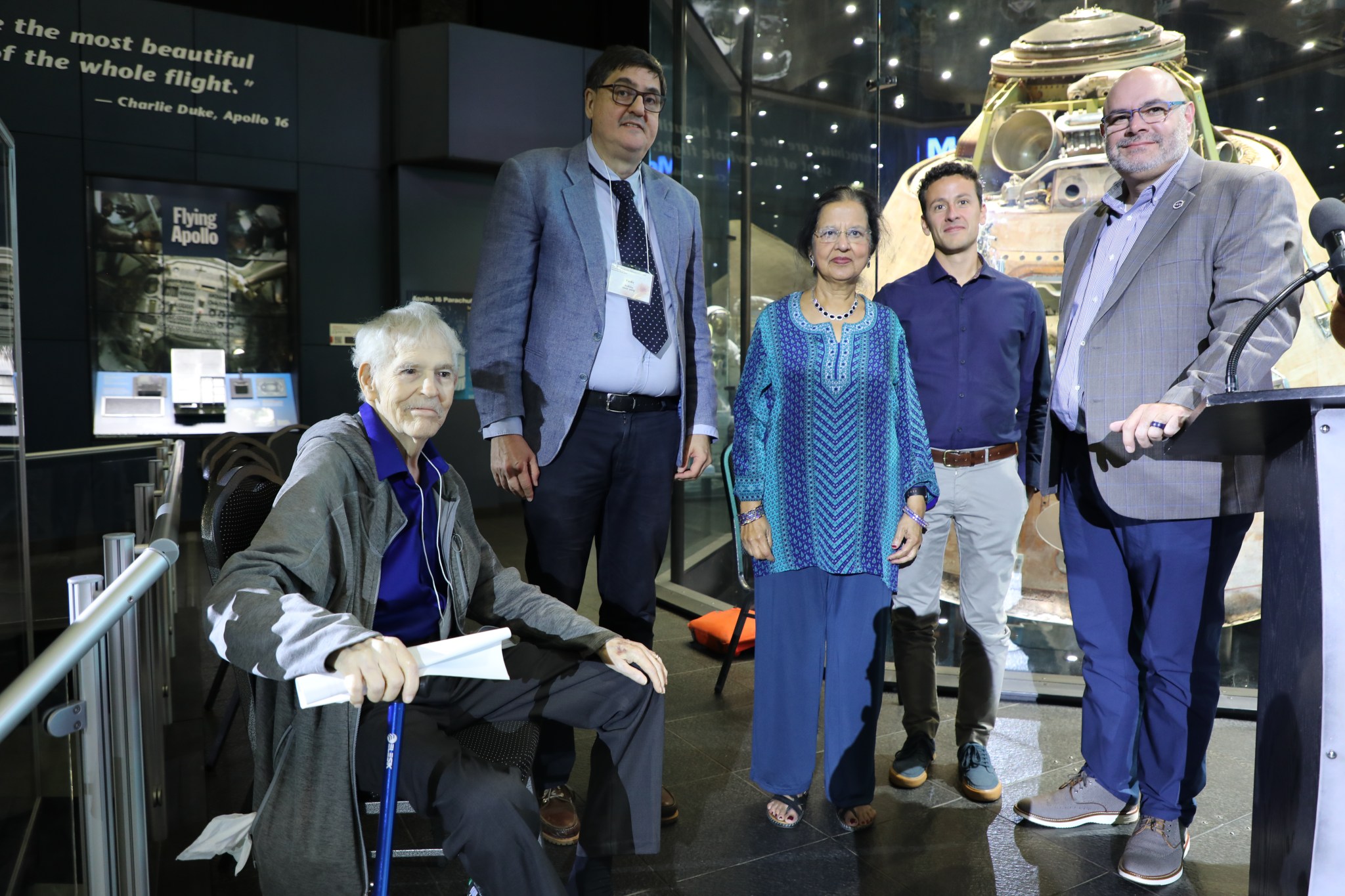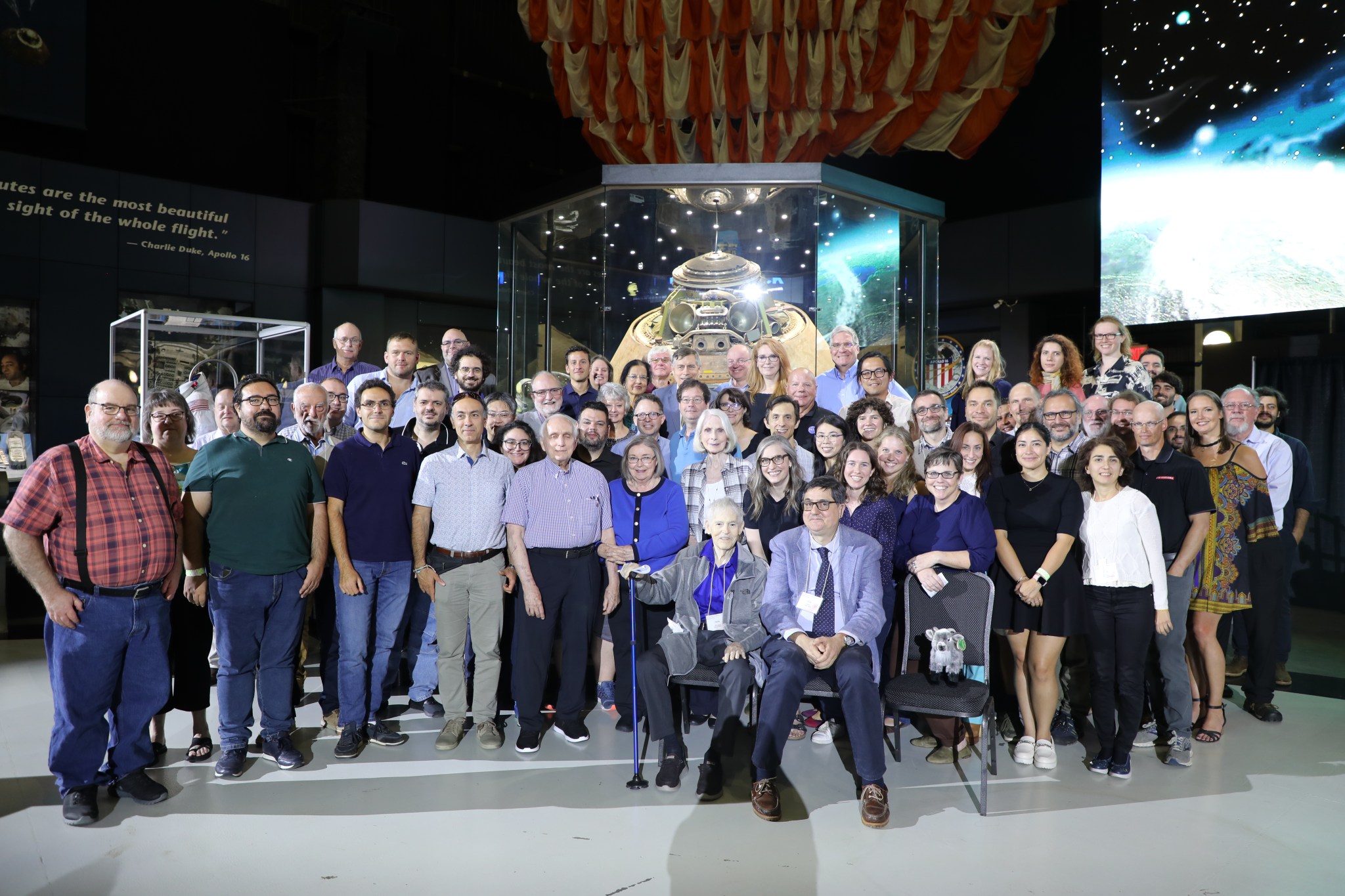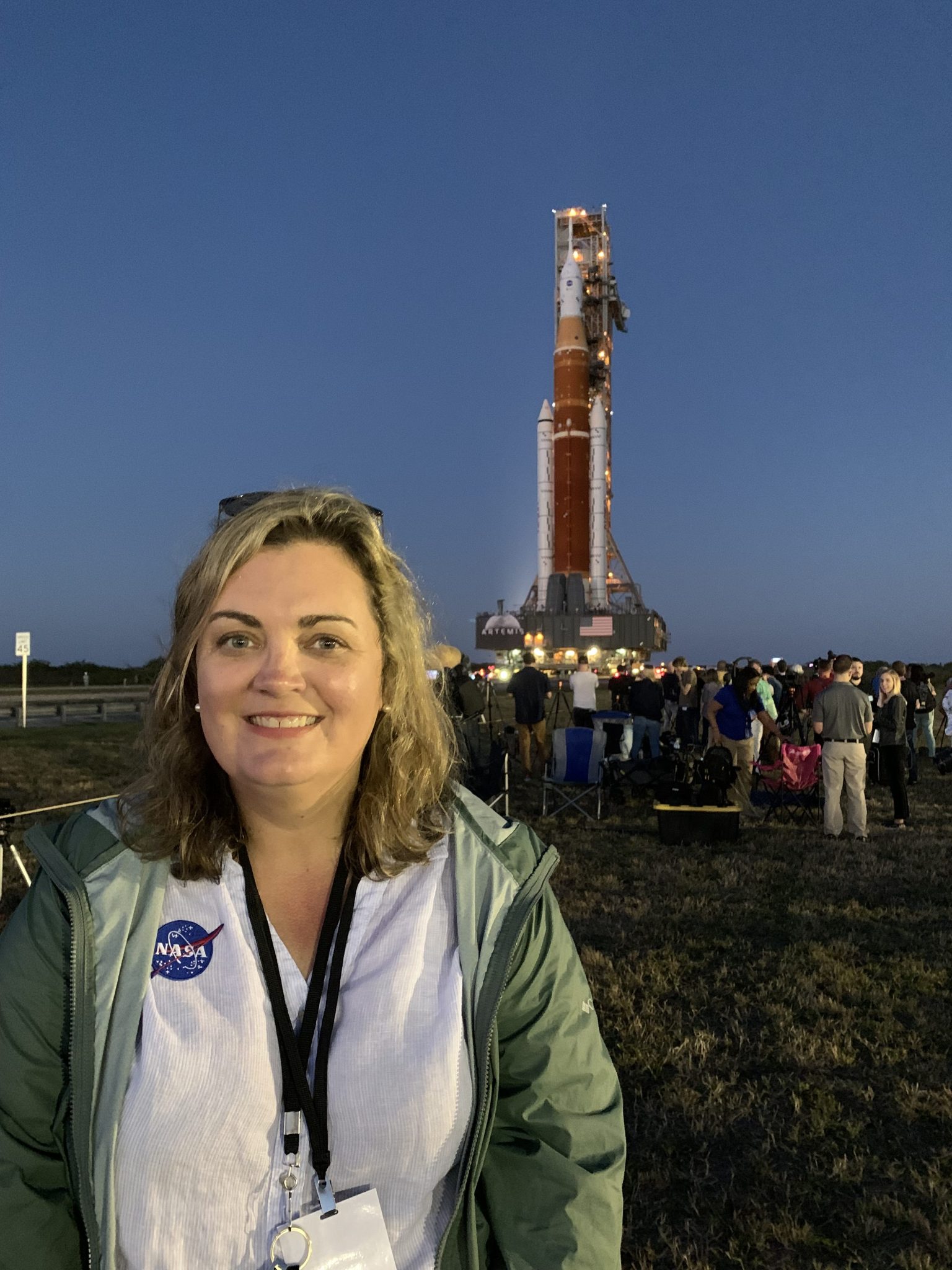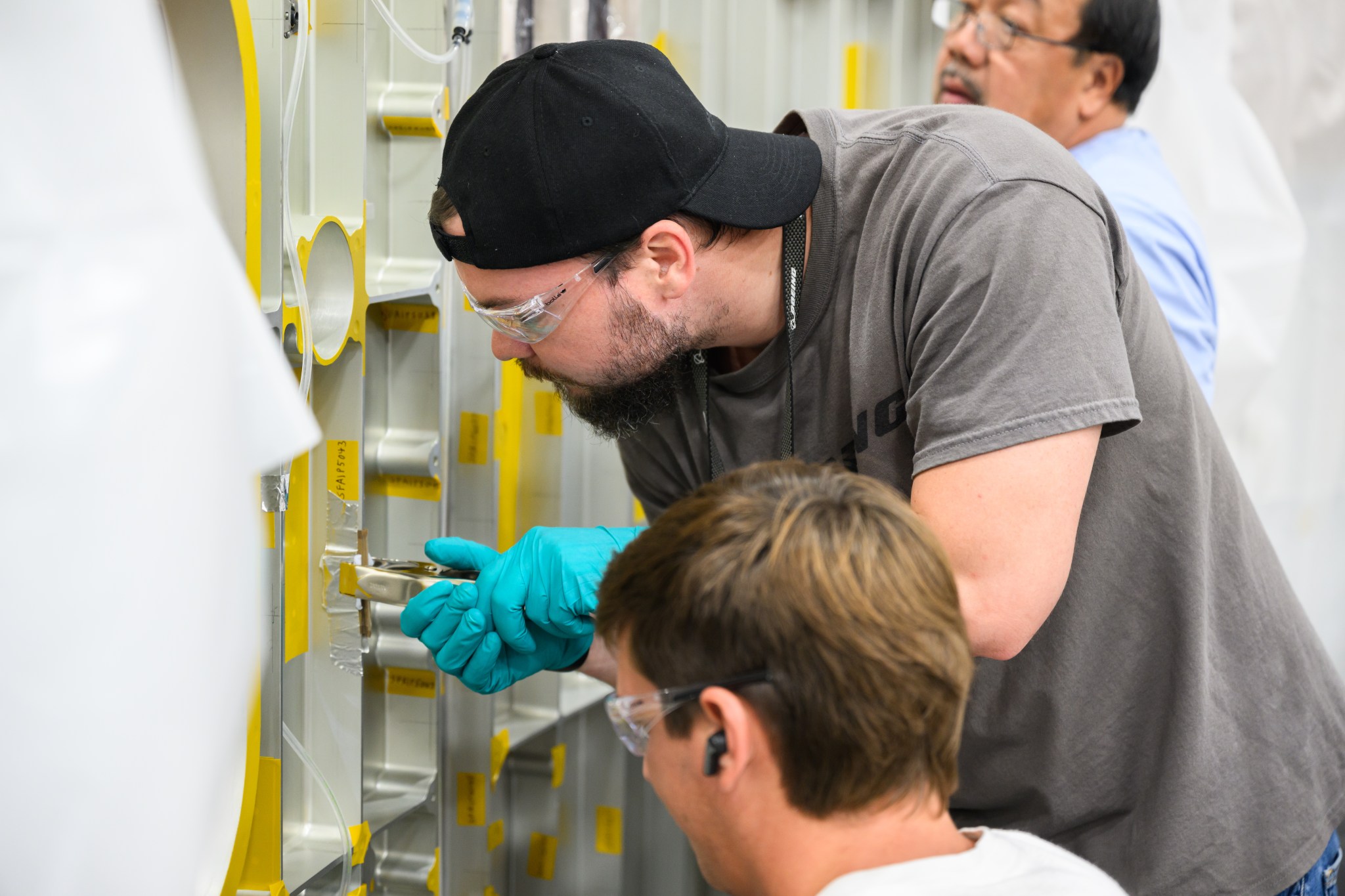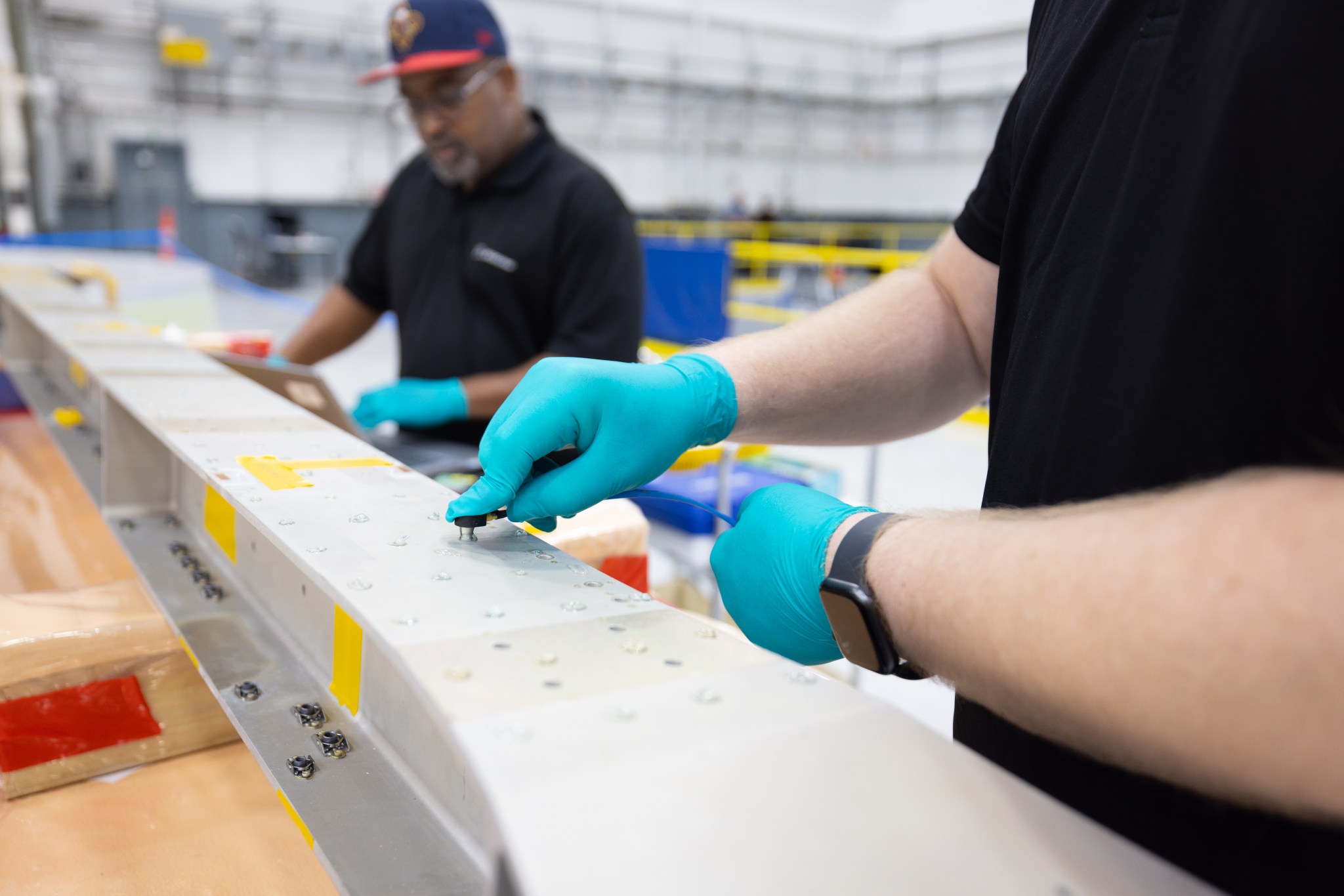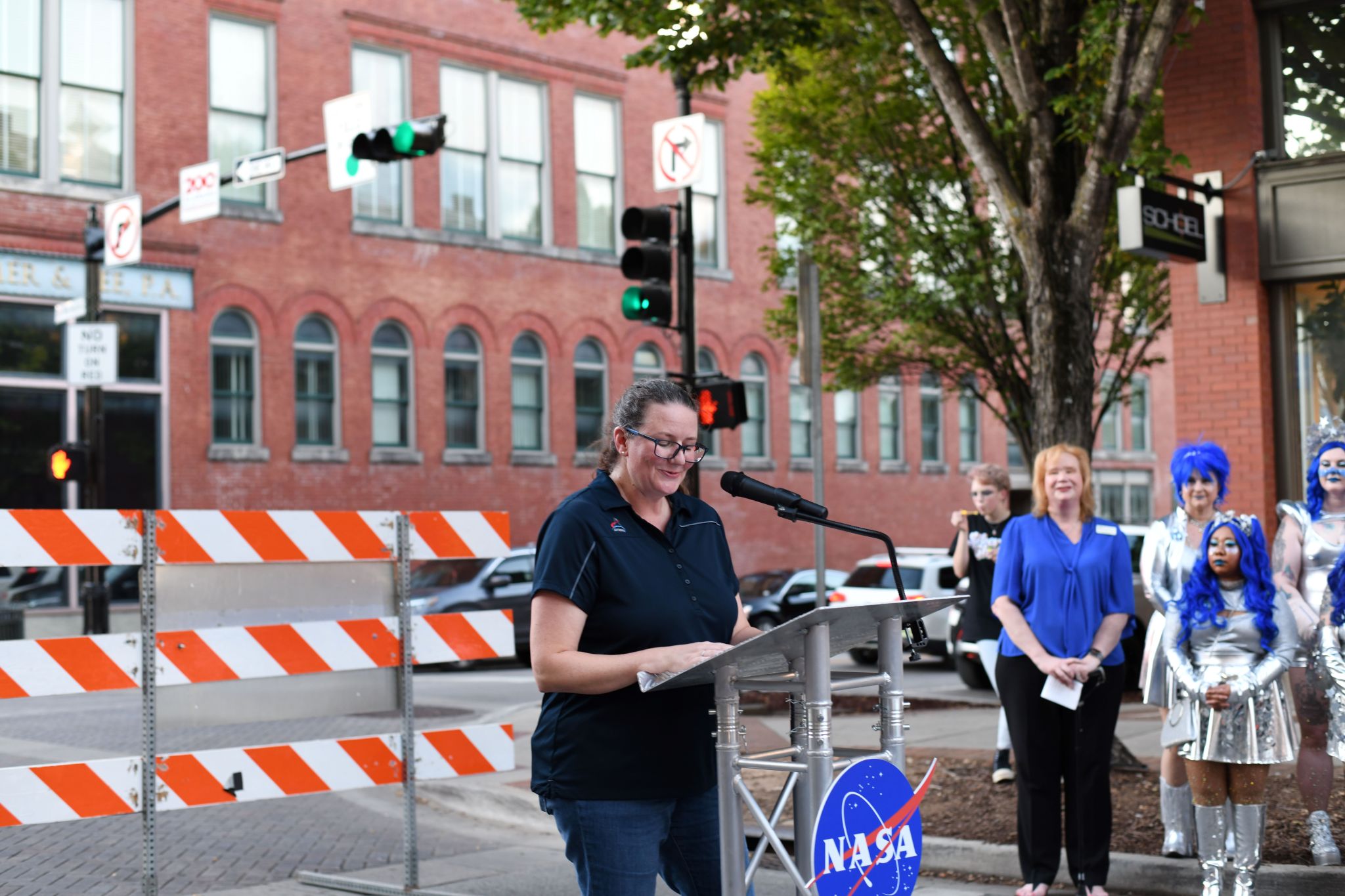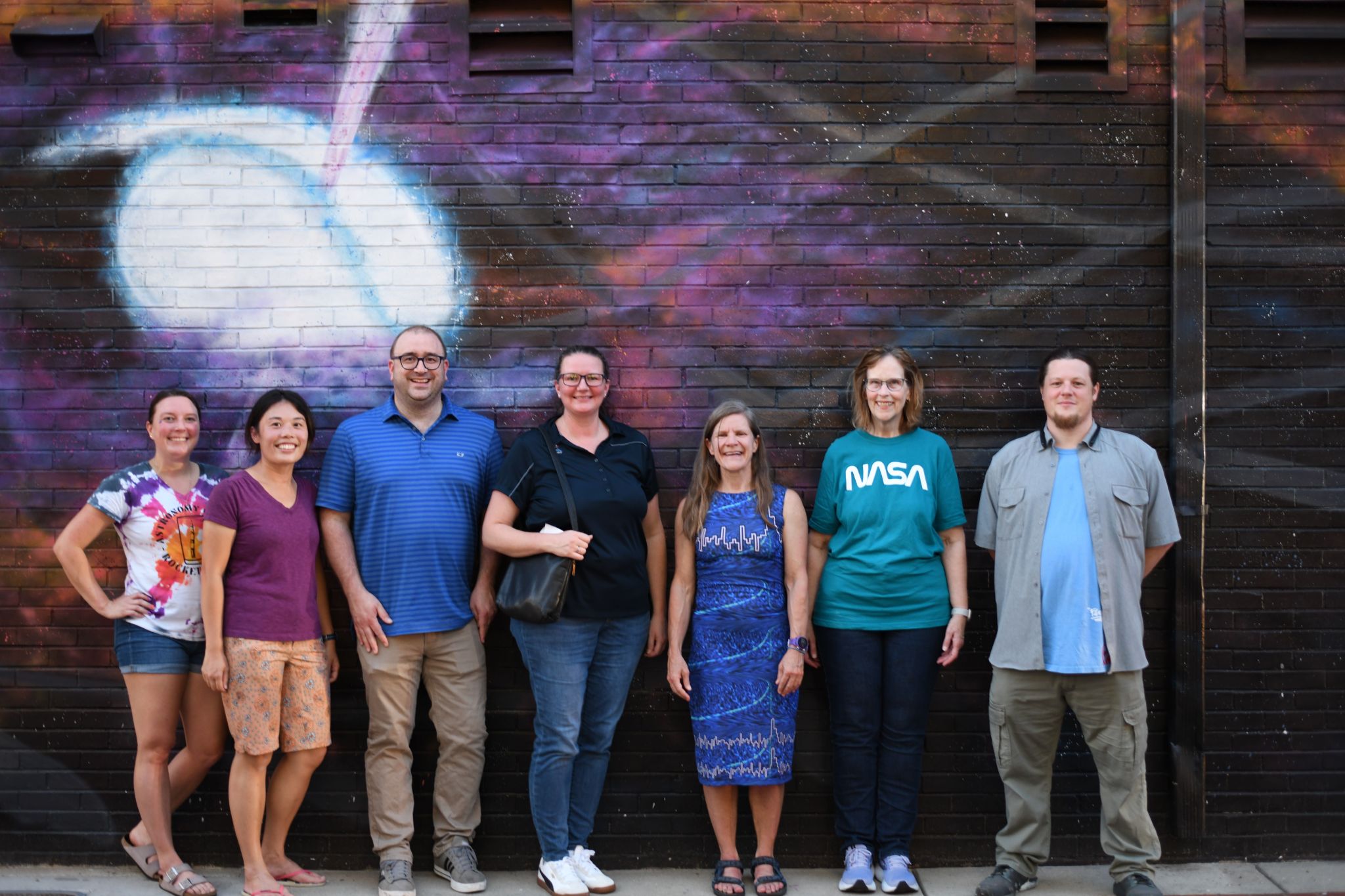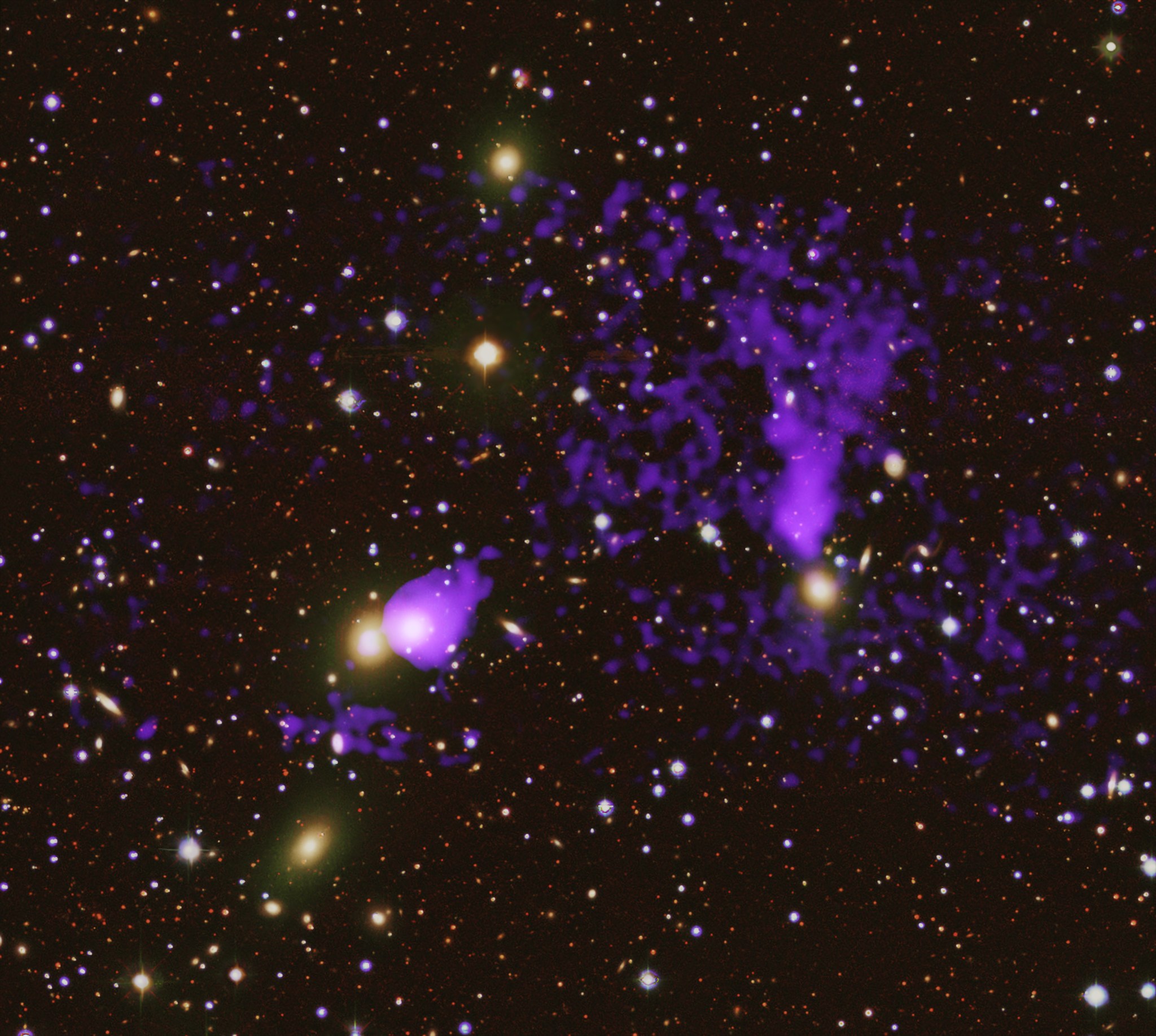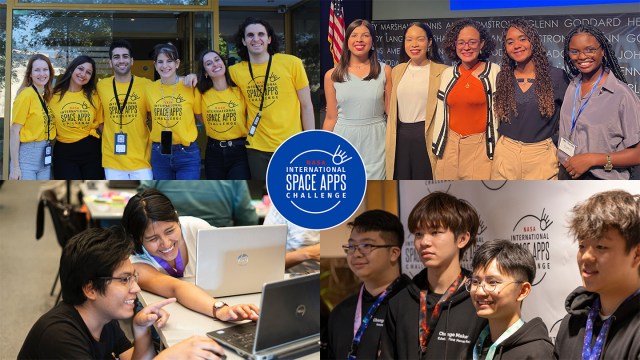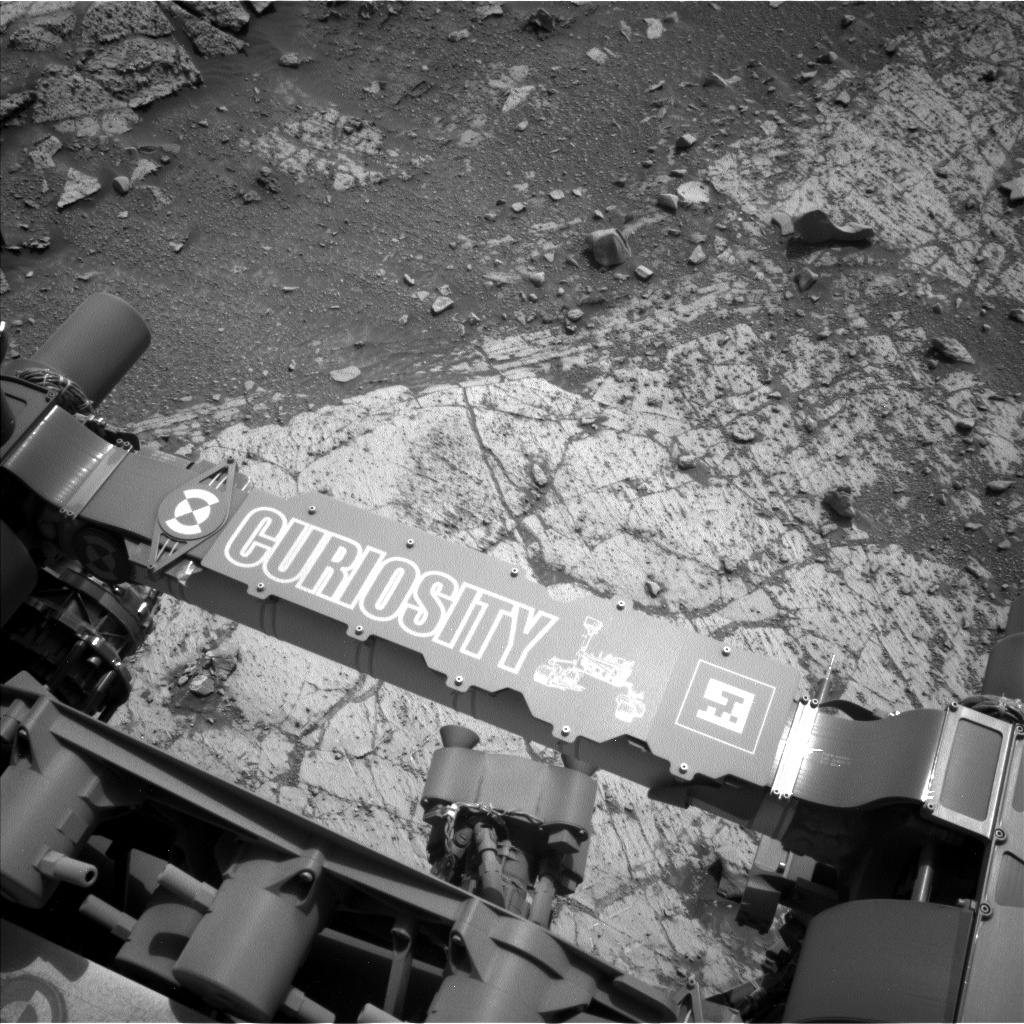The Marshall Star for September 25, 2024
Marshall Presents Small Business Awards for Fiscal Year 2024 By Wayne Smith NASA’s Marshall Space Flight Center honored top contractors, subcontractors, teams, and individuals of fiscal year 2024 at the 38th meeting of Marshall’s Small Business Alliance. The awards honor aerospace companies and leaders who have demonstrated support of the center’s small business programs and […]
The Marshall Star for September 25, 2024
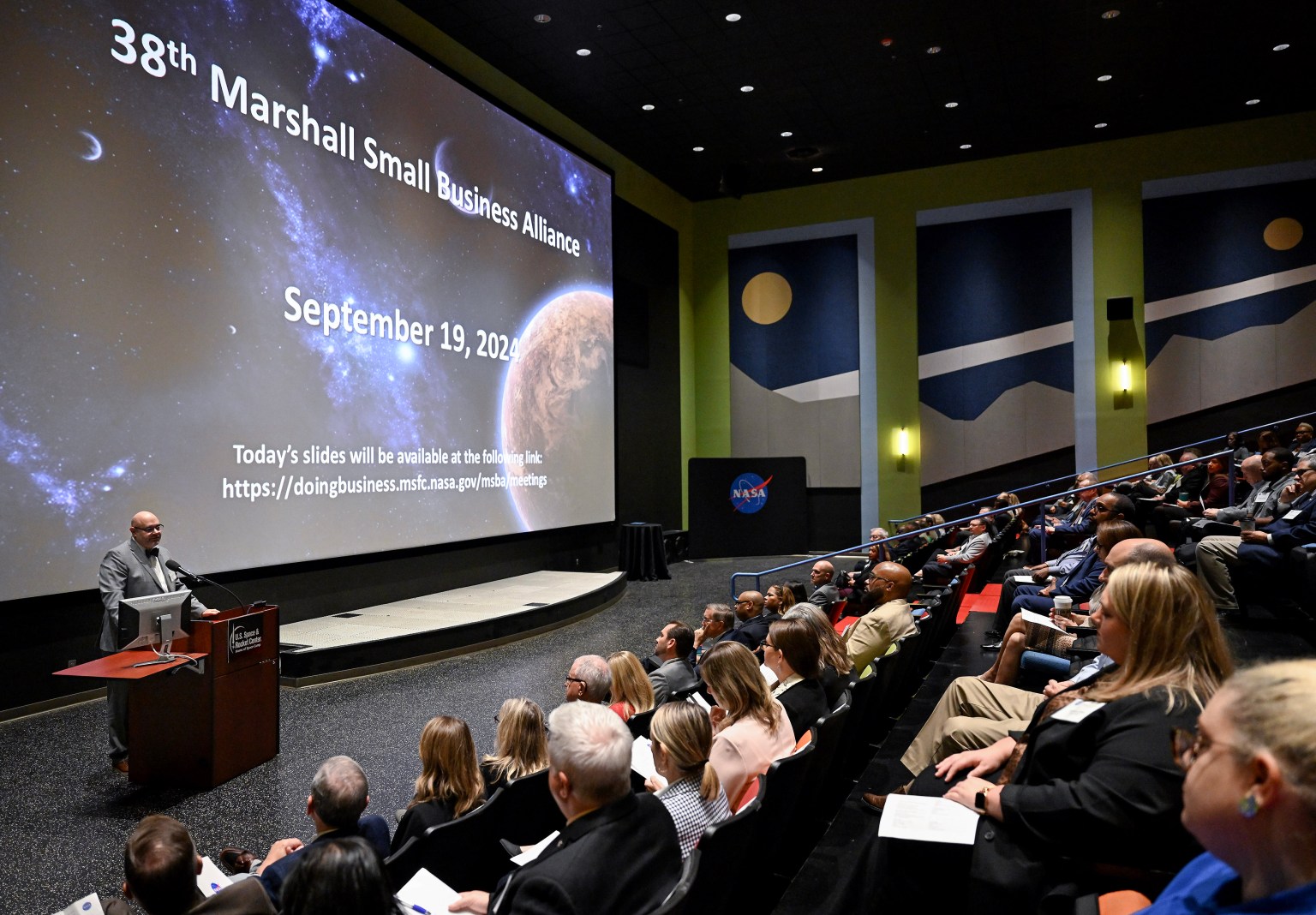
Marshall Presents Small Business Awards for Fiscal Year 2024
By Wayne Smith
NASA’s Marshall Space Flight Center honored top contractors, subcontractors, teams, and individuals of fiscal year 2024 at the 38th meeting of Marshall’s Small Business Alliance. The awards honor aerospace companies and leaders who have demonstrated support of the center’s small business programs and NASA’s mission of exploration.
The event took place Sept. 19 at the U.S. Space & Rocket Center’s Davidson Center for Space Exploration in Huntsville. Around 650 participants from industry and government gathered to network, learn about business opportunities, and recognize outstanding achievements in support of NASA’s mission and the small business community. Those attending represented 32 states and 10 nations.
“The Marshall Small Business Alliance is an outreach tool designed to introduce the business community to the NASA marketplace,” said David Brock, small business specialist for the agency’s Office of Small Business Programs at Marshall. “Those in attendance can gain valuable insight into Marshall’s exciting programs and projects, upcoming procurement opportunities, and get an opportunity to network with Marshall prime contractors.”
Marshall Director Joseph Pelfrey welcomed attendees, while Jeramie Broadway, deputy director of Marshall’s Office of Strategic Analysis and Communications, provided an update on the center for fiscal year 2025 and beyond.
Marshall’s Industry & Advocate Awards are presented annually and reflect leadership in business community and sustained achievement in service to NASA’s mission.
“We are excited about this year’s winners,” Brock said. “Each play a key role in helping NASA achieve successes in support of key programs and projects, including the Human Landing System and Space Launch System rocket. Maintaining and sustaining an experienced and competitive industry base is what makes America strong, and small businesses are at the core of those successes.”
Marshall manages the Human Landing System and Space Launch System programs.
This year’s award recipients are:
Small Business Prime Contractor of the Year
Media Fusion
Small Business Subcontractor of the Year
Zin Technologies
Large Business Prime Contractor of the Year
Jacobs
Mentor-Protégé Agreement of the Year
Jacobs (mentor) and CodePlus (protégé)
Procurement Person of the Year
Joseph Tynes
Program Person of the Year
Patrick McVay
Small Business Technical Coordinator of the Year
Leah Fox
Technical Person of the Year
David Hood
NASA civil service employees nominate eligible individuals and organizations for awards. A panel of NASA procurement and technical officials evaluates each nominee’s business practices, innovative processes, adoption of new technologies and their overall contributions to NASA’s mission and the agency’s Small Business Program.
Award recipients in the following categories become candidates for agency-level Small Business Industry and Advocate Awards:
- Large and Small Business Prime Contractors of the Year
- Small Business Subcontractor of the Year
- Procurement Team or Person
- Technical, Small Business Technical Coordinator/Technical Advisor
- Program Person or Team of the Year
Learn more about Marshall’s small business initiatives.
Smith, a Media Fusion employee and the Marshall Star editor, supports the Marshall Office of Communications.
New Flag Honors Marshall Work on NASA’s Space X Crew-9 Mission
By Serena Whitfield
A new flag is reaching for the Moon outside the Huntsville Operations Support Center at NASA’s Marshall Space Flight Center following a Sept.19 ceremony, marking contributions from center team members toward the launch of NASA’s SpaceX Crew-9 mission.
The Crew-9 mission to the International Space Station will carry NASA astronaut Nick Hague and Roscosmos cosmonaut Aleksandr Gorbunov. The mission is scheduled to launch Sept. 28 no earlier than 12:17 p.m. CDT.
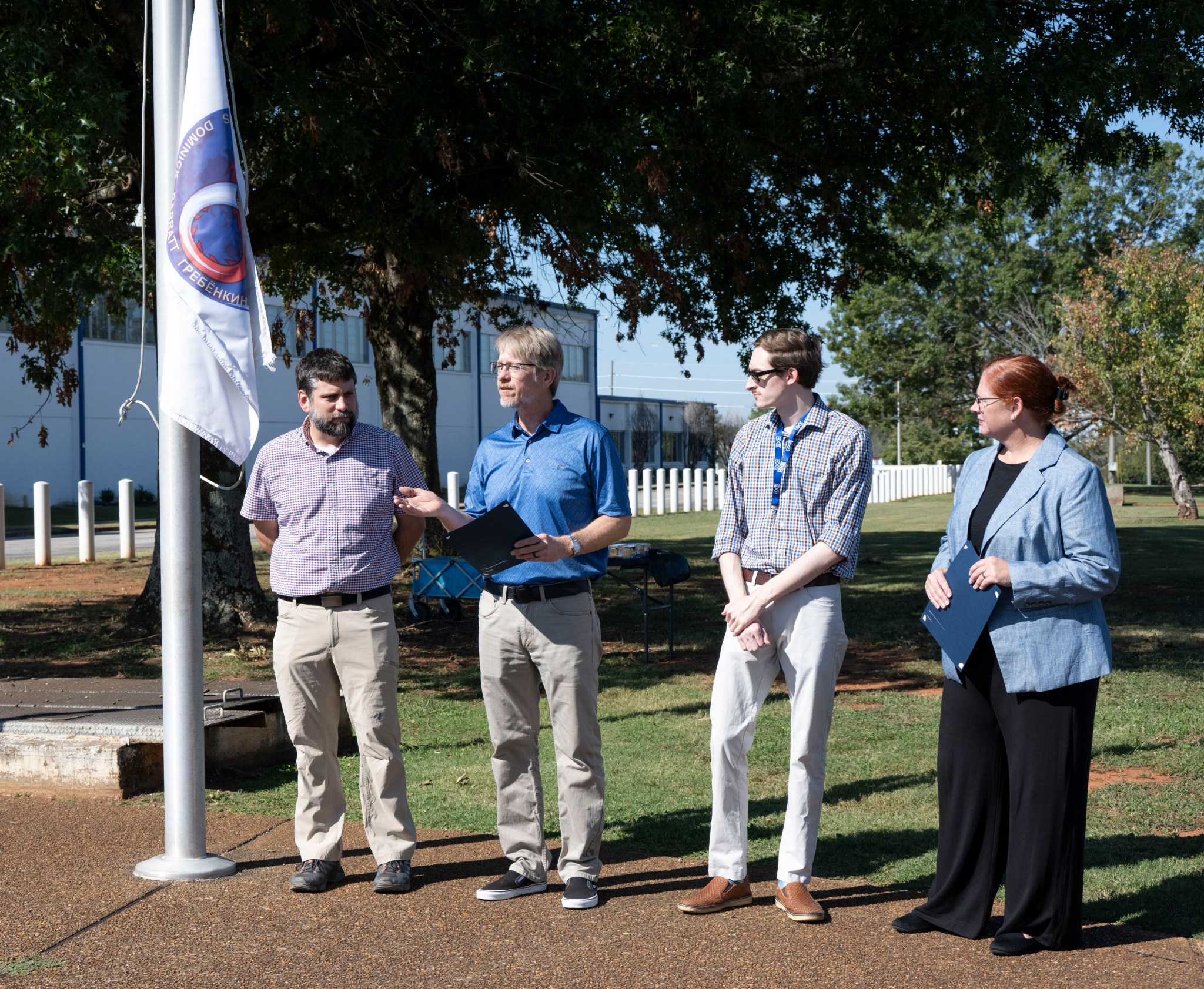
Crew-9 will be the first human spaceflight mission to launch from Space Launch Complex-40 at Cape Canaveral Space Force Station. This is the ninth crew rotation mission with SpaceX to the orbiting laboratory under NASA’s Commercial Crew Program (CCP). The crew will spend approximately five months at the station, conducting more than 200 science and research demonstrations before returning in February 2025.
Once aboard the space station, Hague and Gorbunov will become members of the Expedition 72 crew and perform research, technology demonstrations, and maintenance activities. The pair will join NASA astronauts Don Petitt, Butch Wilmore, Suni Williams, as well as Roscosmos cosmonauts Alexey Ovchinin and Ivan Vagner. Wilmore and Williams, who launched aboard the Starliner spacecraft in June, will fly home with Hague and Gorbunov in February 2025.
The flag raising has been a tradition for missions supported at Marshall’s Huntsville Operations Support Center (HOSC), as well as a tradition within the CCP to celebrate the successful conclusion of NASA’s Agency Flight Readiness Review prior to launch. The HOSC provides engineering and mission operations support for the space station, the CCP, and Artemis missions, as well as science and technology demonstration missions. The Payload Operations Integration Center within HOSC operates, plans, and coordinates the science experiments onboard the space station 365 days a year, 24 hours a day.
The CCP support team at Marshall provides crucial programmatic, engineering, and safety and mission assurance expertise for launch vehicles, spacecraft propulsion, and integrated vehicle performance. Marshall’s role within the CCP is to support certification that the spacecraft and launch vehicle are ready for launch. The support team performs engineering expertise, particularly for propulsion, as well as program management, safety and mission assurance, and spacecraft support.
The flag-raising ceremony was a joint effort between the Payload and Mission Operations Division (PMOD) and CCP team. Dave Gwaltney, technical assistant, specialty systems, and Commercial Crew Program representative, gave the introductions. He recognized Brady Doepke, structural analyst for liquid propulsion systems, for his significant contributions in preparation for Crew-9 mission success. Gwaltney said Doepke exemplified leadership and innovation through his guidance of Marshall’s CCP engineering team, which resulted in a successful risk assessment of the updated SpaceX turbine wheel fleet leader acceptance criteria.
Payload and Mission Operations Division Manager Nicole Pelfrey also recognized Thomas “Reid” Lawrence as the division’s Crew-9 honoree.
“Reid serves dutifully in the HOSC as part of the HOSC’s Data Operations Control Room Operations Engineers,” Pelfrey said. “Reid has a number of technical specialties, including his expertise in the Backup Control Center activation procedures. This expertise has been vital over the past year as JSC has worked through power upgrades. He also diligently ensures our ISS payload users receive their data and is a key engineer for the testing, verification, and operation of our HOSC interfaces that support commercial crew communications.”
Whitfield is an intern supporting the Marshall Office of Communications.
Center Hosts Rossi Prize Recognition Dinner for IXPE
NASA’s Marshall Space Flight Center hosted the Rossi Prize Recognition Dinner at the U.S. Space & Rocket Center in Huntsville on Sept. 18. The dinner was held to recognize the IXPE (Imaging X-ray Polarimetry Explorer) team members honored with the Bruno Rossi Prize, a top prize in high-energy astronomy. From left, Martin Weisskopf, Rossi Prize awardee and NASA emeritus scientist, who served as the principal investigator for IXPE during its development, launch, and commissioning; Paolo Soffitta, Rossi Prize awardee, and the Italian Space Agency’s principal investigator for IXPE; Hashima Hasan, program scientist for IXPE at NASA Headquarters; Andrea Marinucci, IXPE team member and researcher with the Italian Space Agency; and Marshall Director Joseph Pelfrey, who provided welcome remarks at the dinner. “The Bruno Rossi Prize highlights how partnerships and teamwork can push the boundaries of scientific knowledge,” Pelfrey said. “The (IXPE) mission, a groundbreaking collaboration between NASA and the Italian Space Agency, represents over 30 years of dedicated effort and stands as a testament to the innovative work of a truly multinational team.” (NASA/Jennifer Deermer)
Rossi Prize winners Weisskopf and Soffitta, center seated, are joined by a plush goat, the unofficial mascot of the IXPE mission, and other IXPE team members at the Rossi Prize Recognition Dinner. Read more about the award and the prize winners. (NASA/Jennifer Deermer)
Take 5 with Shannon Segovia
By Wayne Smith
Talk with Shannon Segovia for any length of time and you’ll quickly discover the care and enthusiasm she has for her position as director of the Office of Communications at NASA’s Marshall Space Flight Center. And that care and enthusiasm extends to those she works with across the center to share news about Marshall missions and team members.
In her role, Segovia oversees a team responsible for media relations and public affairs, digital and social media, stakeholder relations and engagement, internal and employee communications, and executive communications for the center.
“We manage these activities for the entire center of about 7,000 people, so it is a definitely a very busy job!” said Segovia, a native of Athens, Alabama, who was named as permanent communications director this summer after more than 12 years at Marshall.
She was the deputy director of communications starting in June 2023 after working as Marshall’s news chief and public affairs team lead starting in 2019. From 2012 to 2019, Segovia was a public affairs officer at the center. Prior to joining NASA, she was the communications manager for the Tennessee Valley Authority’s Sequoyah Nuclear Plant near Chattanooga, Tennessee.
At Marshall, she said it’s the people who continue to be her biggest motivators.
“As a public servant, I want the people I serve – the people who follow our channels, listen to the news stories we create, and attend our events – to know why NASA’s missions are important and critical to the world we live in,” Segovia said. “I am so fortunate to have such a brilliant team, and they motivate me daily with their hard work.”
“I’m also motivated by my husband and family because I want to make them proud. I want my nieces and nephews to have a bright future, and I truly believe the work we are doing at NASA will help them do that.”
Question: What excites you most about the future of human space exploration, or your NASA work, and your team’s role it?
Segovia: NASA’s missions depend on public and stakeholder support, and that is what our office does – ensures people know what we are doing at NASA and specifically at Marshall, why it is important, and how our missions are benefiting humanity. From social media posts to events like the South Star music festival to interviews with media outlets and stakeholder tours, we use every channel we can to tell others about the work we are doing at Marshall and NASA. Our office touches every organization at the center, and it is so exciting to have a front seat to everything we are doing to get humans back to the Moon and on to Mars.
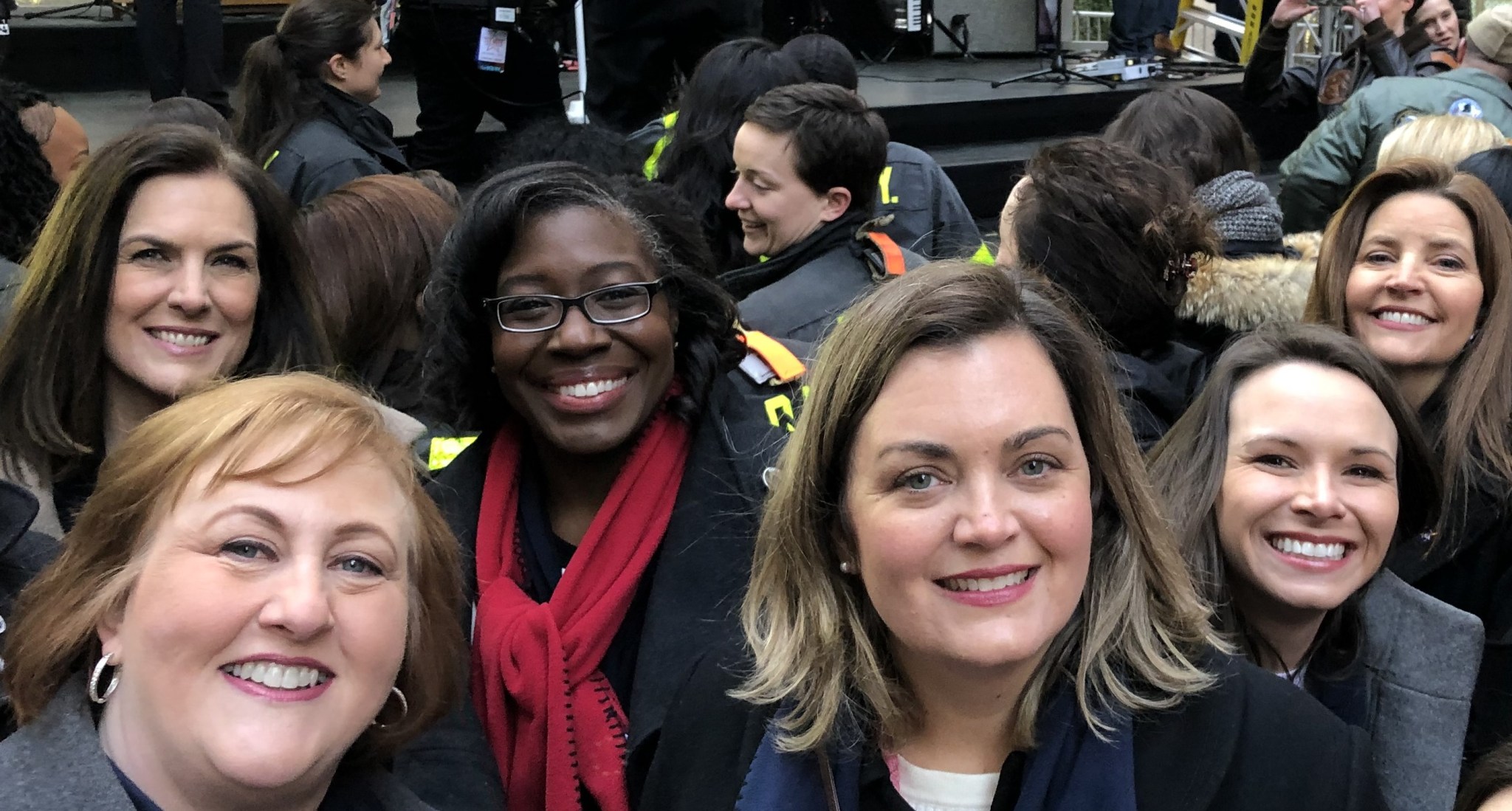
Question: What has been the proudest moment of your career and why?
Segovia: I helped take a team of 12 Marshall female engineers to The Today Show in 2019 for a segment about International Women’s Day. As a public affairs specialist, one of our job duties is to prepare subject matter experts for interviews, making sure they have messages, talking points, and anything else they need. I have never been more proud to be a woman and to work for Marshall than I was that day, seeing how well these women represented NASA and the extraordinary achievements they have made possible. It also made me even more thankful for the job I have – preparing them to make sure they felt confident and could talk about their work was a wonderful experience. The other moment in my career I will never forget is the Artemis I launch in November 2022. I’ve supported the Space Launch System since I started working at NASA, and seeing that rocket fly was one of the best moments of my career. It was the culmination of so much hard work and sacrifice from so many people and was truly an overwhelming and amazing experience.
Question: Who or what inspired you to pursue an education/career that led you to NASA and Marshall?
Segovia: My parents have always been my No. 1 fans, encouragers, and supporters. They instilled in me a strong work ethic and the belief I could do anything I wanted to do if I worked hard. They made education a priority for my brothers and I and would do anything to help us succeed. I am so fortunate to have such a wonderful family. My mom always wanted me to do something in the medical field, but a biology course in college changed my mind quickly on that. I wasn’t sure what I wanted to do but had been at school for two years and needed to declare a major. I liked to write and read but didn’t know how to make a career out of that until I went to a journalism class taught by Ms. Bobbie Hurt at the University of North Alabama, and I was hooked. She became my mentor and really taught me how to be a good writer, which has been the foundation for my entire career. I ended up with a double major in journalism and public relations, and it was one of the best decisions I ever made.
Question: What advice do you have for employees early in their NASA career or those in new leadership roles?
Segovia: Find people to whom you can go to for advice, who have your back, and can help you accomplish your goals. I’ve had some amazing mentors, teammates, and bosses who have not only supported me but pushed me to do things I wasn’t sure I could do and helped me even when I messed up. I would not be here without them, and I think it is so important to have those people in your entire career, but especially when you are new. Ask for help when you need it. Time flies, so enjoy the season and job you are in. You will know when it is time to move on, but being present and learning from where you are will help you succeed.
Question: What do you enjoy doing with your time while away from work?
Segovia: I love the water – ocean, river, pool, lake – I like being outside and water activities. I love to read and travel, and also to spend time with family and friends. I have three nieces and two nephews, and I like to go to their games and activities. I have a 4-year-old terrier mix named Ted and I enjoy taking him on walks and to the park.
Smith, a Media Fusion employee and the Marshall Star editor, supports the Marshall Office of Communications.
NASA Awards $1.5 Million at Watts on the Moon Challenge Finale
NASA has awarded a total of $1.5 million to two U.S. teams for their novel technology solutions addressing energy distribution, management, and storage as part of the agency’s Watts on the Moon Challenge. The innovations from this challenge aim to support NASA’s Artemis missions, which will establish long-term human presence on the Moon.
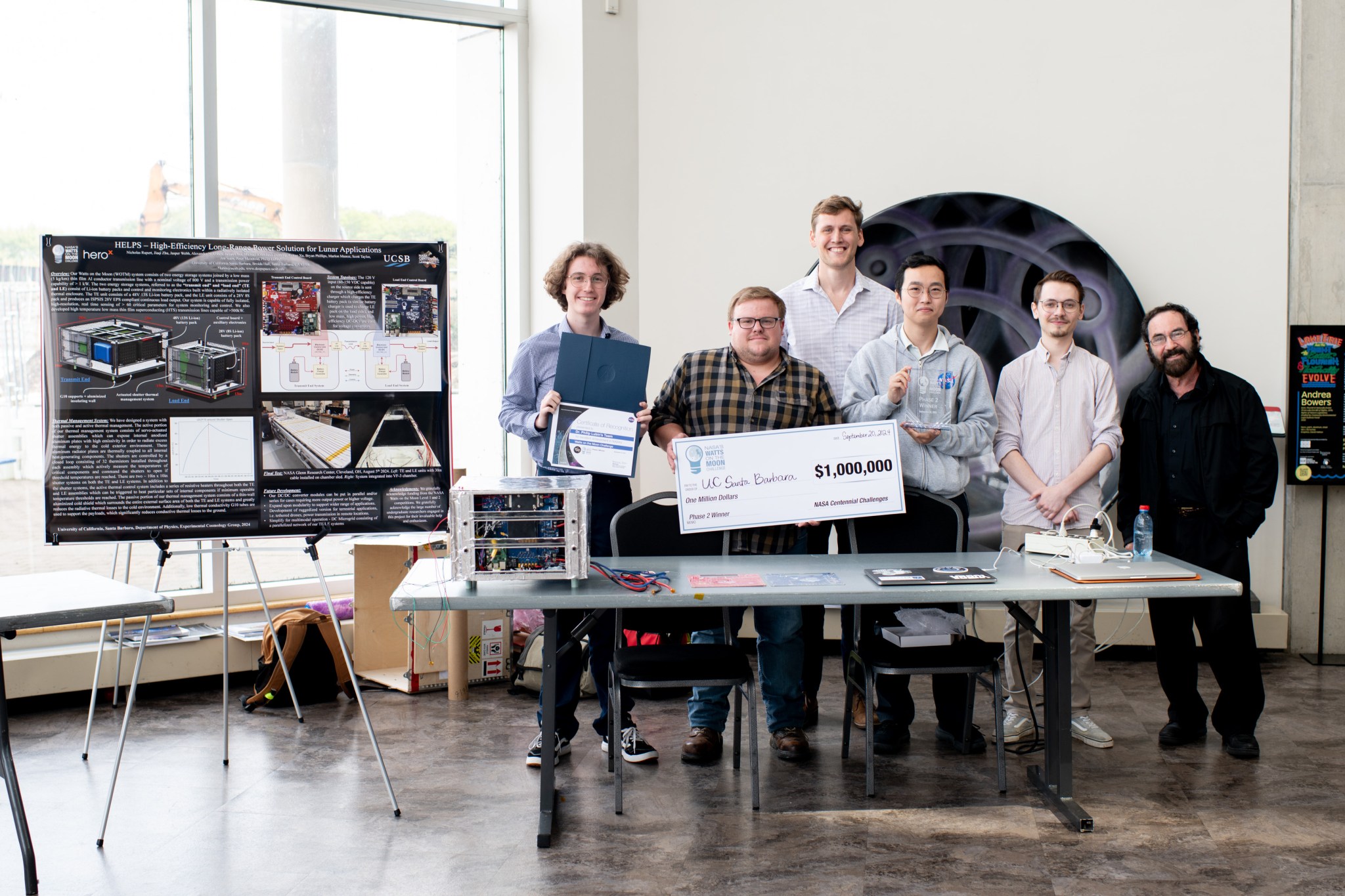
This two-phase competition has challenged U.S. innovators to develop breakthrough power transmission and energy storage technologies that could enable long-duration Moon missions to advance the nation’s lunar exploration goals. The final phase of the challenge concluded with a technology showcase and winners’ announcement ceremony Sept. 20 at Great Lakes Science Center in Cleveland, Ohio, home of the visitor center for NASA’s Glenn Research Center.
“Congratulations to the finalist teams for developing impactful power solutions in support of NASA’s goal to sustain human presence on the Moon,” said Kim Krome-Sieja, acting program manager for Centennial Challenges at NASA’s Marshall Space Flight Center. “These technologies seek to improve our ability to explore and make discoveries in space and could have implications for improving power systems on Earth.”
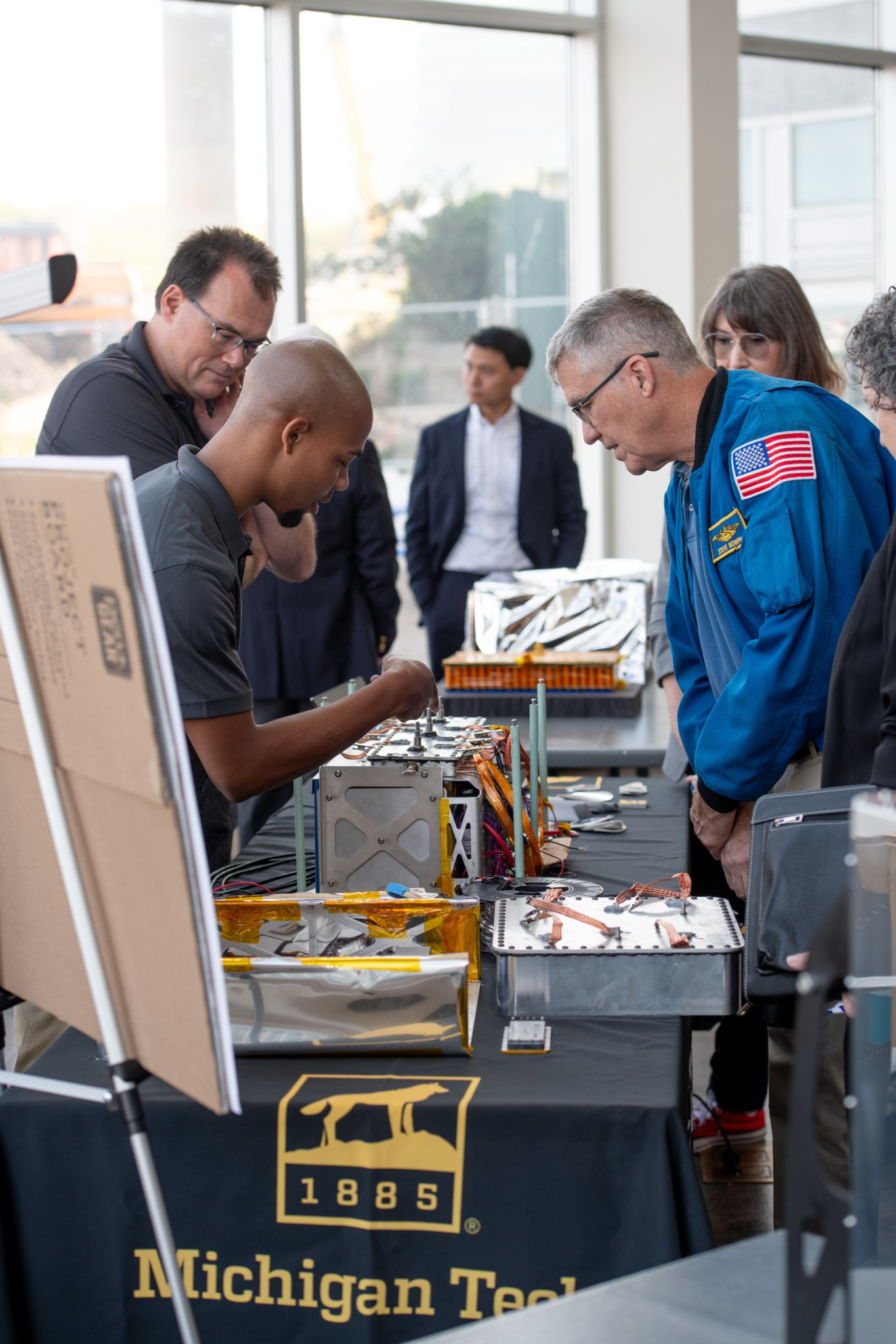
The winning teams are:
- First prize ($1 million): H.E.L.P.S. (High Efficiency Long-Range Power Solution) of Santa Barbara, California
- Second prize ($500,000): Orbital Mining Corporation of Golden, Colorado
Four teams were invited to refine their hardware and deliver full system prototypes in the final stage of the competition, and three finalist teams completed their technology solutions for demonstration and assessment at Glenn. The technologies were the first power transmission and energy storage prototypes to be tested by NASA in a vacuum chamber mimicking the freezing temperature and absence of pressure found at the permanently shadowed regions of the Lunar South Pole. The simulation required the teams’ power systems to demonstrate operability over six hours of solar daylight and 18 hours of darkness with the user three kilometers (nearly two miles) away from the power source.
During this competition stage, judges scored the finalists’ solutions based on a Total Effective System Mass (TESM) calculation, which measures the effectiveness of the system relative to its size and weight – or mass – and the total energy provided by the power source. The highest-performing solution was identified based on having the lowest TESM value – imitating the challenges that space missions face when attempting to reduce mass while meeting the mission’s electrical power needs.
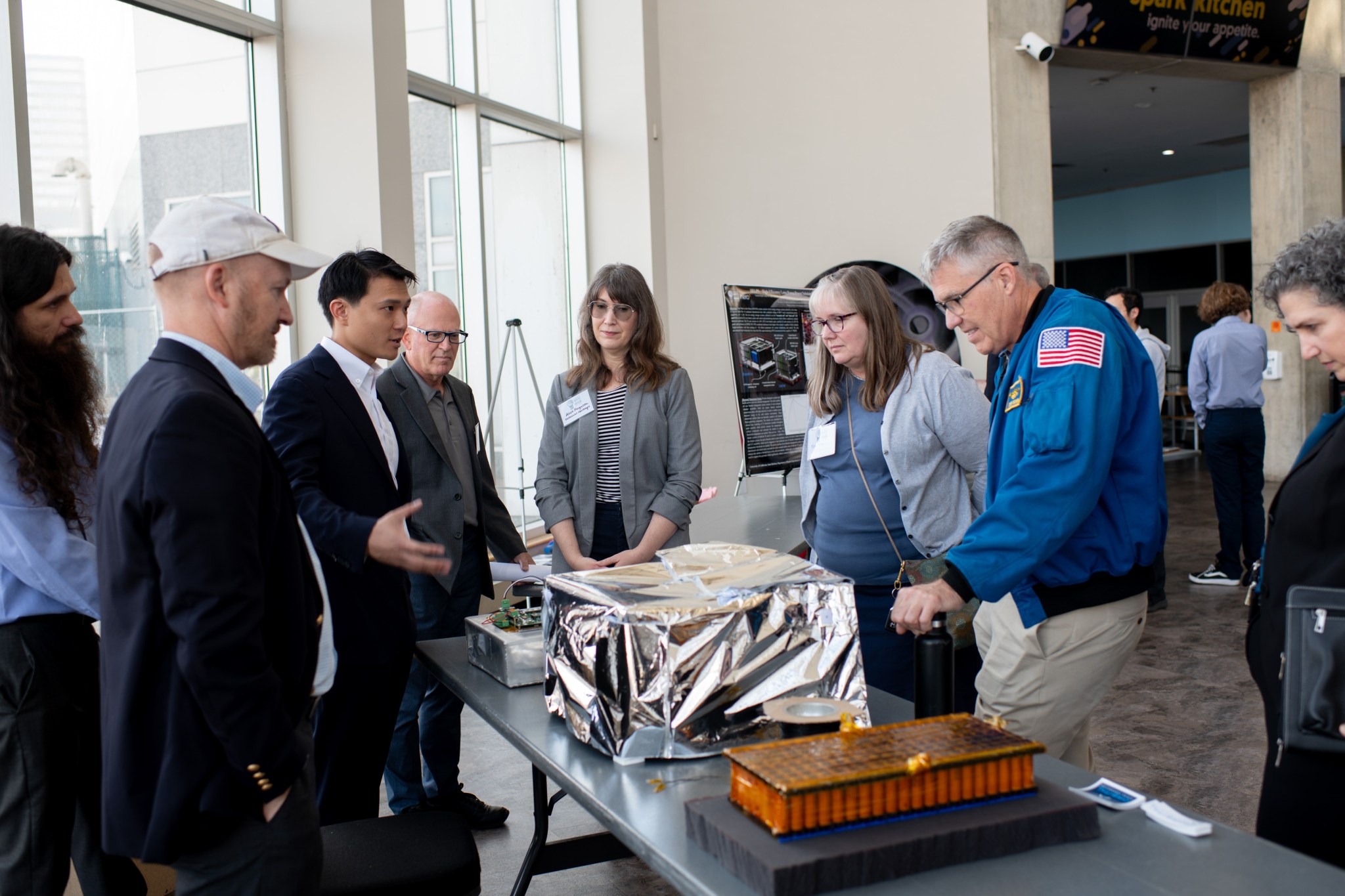
Team H.E.L.P.S. (High Efficiency Long-Range Power Solution) from University of California, Santa Barbara, won the grand prize for their hardware solution, which had the lowest mass and highest efficiency of all competitors. The technology also featured a special cable operating at 800 volts and an innovative use of energy storage batteries on both ends of the transmission system. They also employed a variable radiation shield to switch between conserving heat during cold periods and disposing of excess heat during high power modes. The final 48-hour test proved their system design effectively met the power transmission, energy storage, and thermal challenges in the final phase of competition.
Orbital Mining Corporation, a space technology startup, received the second prize for its hardware solution that also successfully completed the 48-hour test with high performance. They employed a high-voltage converter system coupled with a low-mass cable and a lithium-ion battery.
“The energy solutions developed by the challenge teams are poised to address NASA’s space technology priorities,” said Amy Kaminski, program executive for Prizes, Challenges, and Crowdsourcing in NASA’s Space Technology Mission Directorate at NASA Headquarters. “These solutions support NASA’s recently ranked civil space shortfalls, including in the top category of surviving and operating through the lunar night.”
During the technology showcase and winners’ announcement ceremony, NASA experts, media, and members of the public gathered to see the finalist teams’ technologies and hear perspectives from the teams’ participation in the challenge. After the winners were announced, event attendees were also welcome to meet NASA astronaut Stephen Bowen.
The Watts on the Moon Challenge is a NASA Centennial Challenge led by Glenn. Marshall manages Centennial Challenges, which are part of the agency’s Prizes, Challenges, and Crowdsourcing program in the Space Technology Mission Directorate. NASA contracted HeroX to support the administration of this challenge.
Michoud Continues Work on Evolved Stage of SLS Rocket for Future Artemis Missions
Manufacturing equipment that will be used to build components for NASA’s SLS (Space Launch System) rocket for future Artemis missions is being installed at the agency’s Michoud Assembly Facility.
The novel tooling will be used to produce the SLS rocket’s advanced exploration upper stage, or EUS, in the factory’s new manufacturing area. The EUS will serve as the upper, or in-space, stage for all Block 1B and Block 2 SLS flights in both crew and cargo configurations.
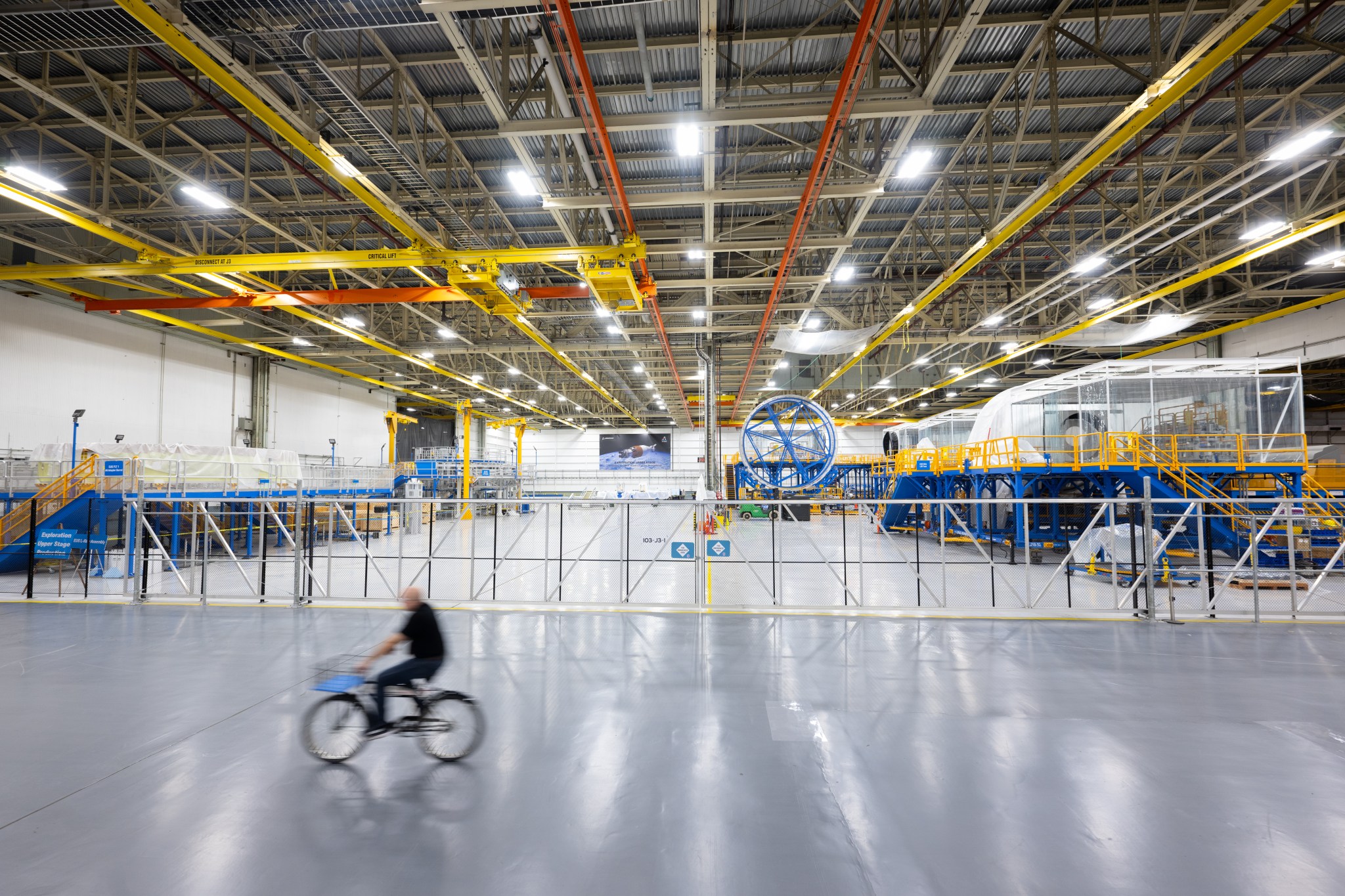
In tandem, NASA and Boeing, the SLS lead contractor for the core stage and exploration upper stage, are producing structural test articles and flight hardware structures for the upper stage at Michoud and the agency’s Marshall Space Flight Center. Early manufacturing is already underway at Michoud while preparations for an engine-firing test series for the upper stage are in progress at nearby Stennis Space Center.
“The newly modified manufacturing space for the exploration upper stage signifies the start of production for the next evolution of SLS Moon rockets at Michoud,” said Hansel Gill, director at Michoud. “With Orion spacecraft manufacturing and SLS core stage assembly in flow at Michoud for the past several years, standing up a new production line and enhanced capability at Michoud for EUS is a significant achievement and a reason for anticipation and enthusiasm for Michoud and the SLS Program.”
The advanced upper stage for SLS is planned to make its first flight with Artemis IV and replaces the single-engine Interim Cryogenic Propulsion Stage (ICPS) that serves as the in-space stage on the initial SLS Block 1 configuration of the rocket. With its larger liquid hydrogen and liquid oxygen propellant tanks feeding four L3 Harris Technologies- built RL10C-3 engines, the EUS generates nearly four times the thrust of the ICPS, providing unrivaled lift capability to the SLS Block 1B and Block 2 rockets and making a new generation of crewed lunar missions possible.
This upgraded and more powerful rocket will increase the SLS rocket’s payload to the Moon by 40%, from 27 metric tons (59,525 lbs.) with Block 1 to 38 metric tons (83,776 lbs.) in the crew configuration. Launching crewed missions along with other large payloads enables multiple large-scale objectives to be accomplished in a single mission.
Through the Artemis campaign, NASA will land the first woman, first person of color, and its first international partner astronaut on the Moon. The rocket is part of NASA’s deep space exploration plans, along with the Orion spacecraft, supporting ground systems, advanced spacesuits and rovers, Gateway in orbit around the Moon, and commercial human landing systems. NASA’s SLS is the only rocket that can send Orion, astronauts, and supplies to the Moon in a single launch.
NASA’s Marshall Space Flight Center manages the SLS Program and Michoud.
I am Artemis: Chris Pereira
Chris Pereira can personally attest to the immense gravitational attraction of black holes. He’s been in love with space ever since he saw a video on the topic in a high school science class.
But it wasn’t just any science class. It was one specially designed for English learners.

“I was born and raised in Guatemala,” Pereira said. “I came here at 14 unable to speak any English.”
Pereira did not know how to navigate the U.S. educational system either, but after that class, he was certain he wanted a career in space.
Thus began a journey that ultimately landed him at L3Harris Technologies, where he works in the Aerojet Rocketdyne segment as an engineer and operations integrator on the RS-25 engine – used to power the core stage of NASA’s SLS (Space Launch System) rocket that will launch astronauts to the Moon under NASA’s Artemis campaign.
Pereira’s first step was to stay after class and ask to borrow a copy of the video on black holes. His teacher not only obliged but took him across the street to the local library to get his first library card.
Pereira quickly recognized that the pathway to his desired career in space was through higher education. It was equally clear, however, that he was not yet on that pathway. English as a Second Language classes, including that science class, did not count toward college admissions. His guidance counselor, meanwhile, was nudging him toward the trades.
But with the help of teachers and a new guidance counselor, he got himself on the college-bound track.
“I came to understand there were multiple career pathways to explore my interest in space,” Pereira said. “One was engineering.”
There was a lot of catching up to do, so Pereira took eight classes per day, including honors courses. He also worked every day after school cleaning a gymnasium from 6 to 11 p.m. to help his family make ends meet.
Pereira earned his mechanical engineering degree at California State University at Los Angeles while also working as a senior educator at the California Science Center to cover the cost of his college tuition and living expenses.
Pereira’s first career experience was as an intern in manufacturing engineering at Aerojet Rocketdyne. “I learned that making 100% mission-success engines requires a strong culture of attention to detail, teamwork and solid work ethics.” Pereira said. His first full-fledged engineering job was with Honeywell Aerospace working on aircraft programs.
Eventually, space came calling – literally. “My mentor at Aerojet Rocketdyne called me up and said, ‘Chris, I have a job for you,’” Pereira said.
He began his new job working on rocket engine programs including the AR1 and RS-68 but shifted to the RS-25 after NASA awarded Aerojet Rocketdyne a contract for newly manufactured versions of the engine. Initial versions of the SLS are using refurbished engines from the Space Shuttle Program. Evolved versions of the RS-25 recently concluded a critical test series and will debut with the fifth Artemis flight.
As RS-25’s operations integrator, Pereira is responsible for ensuring that the many pieces of the program – from tracking on-time procurement of supplies and labor loads to coordinating priorities on various in-demand machine centers – come together to deliver a quality product.
Playing a key role in the nation’s effort to return astronauts to the Moon feels a bit like coming home again, Pereira said. “You develop your first love, work really hard, take different pathways and encounter new passions,” he said. “It’s almost funny how the world and life work out – it’s like I’ve taken a big circle back to my first love.”
NASA is working to land the first woman, first person of color, and its first international partner astronaut on the Moon under Artemis. SLS is part of NASA’s backbone for deep space exploration, along with the Orion spacecraft, supporting ground systems, advanced spacesuits and rovers, the Gateway in orbit around the Moon, and commercial human landing systems. SLS is the only rocket that can send Orion, astronauts, and supplies to the Moon in a single launch.
NASA’s Marshall Space Flight Center manages the SLS Program.
Read other I Am Artemis features.
‘Legacy of the Invisible’ Event Celebrates Mural, Marshall’s Astrophysics Missions
Renee Weber, chief scientist at NASA’s Marshall Space Flight Center, talks during the “Legacy of the Invisible” event in downtown Huntsville on Sept. 20. About 300 people attended the event, which coincided with the 25th anniversary of the launch of the Chandra X-ray Observatory. The celebration featured “No Straight Lines,” a new mural at the corner of Clinton Avenue and Washington Street by local artist Float. The mural honors Huntsville’s rich scientific legacy in astrophysics and highlights the groundbreaking discoveries made possible by Marshall scientists and engineers. Other speakers included Collen Wilson-Hodge, principal investigator of the Fermi Gamma-ray Space Telescope. The event also offered members of the community the opportunity to meet the scientists who worked on some of NASA’s most revolutionary astrophysics missions. Featured exhibits from Marshall included the Apollo Telescope mount, the main science instrument on Skylab; the High Energy Astrophysics Program (HEAO); the BATSE instrument on the Compton Gamma-ray Observatory; Chandra X-ray Observatory; Fermi; IXPE (Imaging X-ray Polarimetry Explorer); and Marshall’s X-Ray and Cryogenic Facility. “I had a really nice time at the event,” Weber said. “It’s always great to see such interest and enthusiasm in our science work from the public.” Wilson-Hodge said the mural is an artistic depiction of the historic event detected with the Fermi Gamma-ray Burst Monitor and the Laser Interferometer Gravitational-wave Observatory on Aug. 17, 2017. “On that day, for the first time ever, we observed both a gamma-ray burst and gravitational waves from two very dense neutron stars merging to form a black hole,” she said. (NASA/Serena Whitfield)
From left to right, scientists and astrophysicists from Marshall, Cori Fletcher, Michelle Hui, Steven Ehlert, Weber, Colleen Wilson-Hodge, Lisa Gibby, and the artist Float pose for a photo in front of the “No Straight Lines” mural at the corner of Clinton Avenue and Washington Street in Huntsville. (NASA/Serena Whitfield)
Chandra Finds Galaxy Cluster that Crosses the Streams
Astronomers using NASA’s Chandra X-ray Observatory have found a galaxy cluster has two streams of superheated gas crossing one another. This result shows that crossing the streams may lead to the creation of new structure.
Researchers have discovered an enormous, comet-like tail of hot gas – spanning over 1.6 million light-years long – trailing behind a galaxy within the galaxy cluster called Zwicky 8338 (Z8338 for short). This tail, spawned as the galaxy had some of its gas stripped off by the hot gas it is hurtling through, has split into two streams.
This is the second pair of tails trailing behind a galaxy in this system. Previously, astronomers discovered a shorter pair of tails from a different galaxy near this latest one. This newer and longer set of tails was only seen because of a deeper observation with Chandra that revealed the fainter X-rays.
Astronomers now have evidence that these streams trailing behind the speeding galaxies have crossed one another. Z8338 is a chaotic landscape of galaxies, superheated gas, and shock waves (akin to sonic booms created by supersonic jets) in one relatively small region of space. These galaxies are in motion because they were part of two galaxy clusters that collided with each other to create Z8338.
This new composite image shows this spectacle. X-rays from Chandra (represented in purple) outline the multimillion-degree gas that outweighs all of the galaxies in the cluster. The Chandra data also shows where this gas has been jettisoned behind the moving galaxies. Meanwhile an optical image from the Dark Energy Survey from the Cerro Tololo Inter-American Observatory in Chile shows the individual galaxies peppered throughout the same field of view.
The original gas tail discovered in Z8338 is about 800,000 light-years long and is seen as vertical in this image. The researchers think the gas in this tail is being stripped away from a large galaxy as it travels through the galaxy cluster. The head of the tail is a cloud of relatively cool gas about 100,000 light-years away from the galaxy it was stripped from. This tail is also separated into two parts.
The team proposes that the detachment of the tail from the large galaxy may have been caused by the passage of the other, longer tail. Under this scenario, the tail detached from the galaxy because of the crossing of the streams.
The results give useful information about the detachment and destruction of clouds of cooler gas like those seen in the head of the detached tail. This work shows that the cloud can survive for at least 30 million years after it is detached. During that time, a new generation of stars and planets may form within it.
The Z8338 galaxy cluster and its jumble of galactic streams are located about 670 million light-years from Earth. A paper describing these results appeared in the Aug. 8, 2023, issue of the Monthly Notices of the Royal Astronomical Society and is available here.
NASA’s Marshall Space Flight Center manages the Chandra program. The Smithsonian Astrophysical Observatory’s Chandra X-ray Center controls science operations from Cambridge, Massachusetts, and flight operations from Burlington, Massachusetts.
Read more from NASA’s Chandra X-ray Observatory.
New Video Series Spotlights Engineers on NASA’s Europa Clipper Mission
What does it take to build a massive spacecraft that will seek to determine if a mysterious moon has the right ingredients for life? Find out in a new video series called “Behind the Spacecraft,” which offers behind-the-scenes glimpses into the roles of five engineers working on NASA’s Europa Clipper mission, from building the spacecraft’s communications systems to putting it through rigorous tests so the orbiter can meet its science goals in space.
With its launch period opening Oct. 10, Europa Clipper is the agency’s first mission dedicated to exploring an ocean world beyond Earth. The spacecraft will travel 1.8 billion miles to the Jupiter system, where it will investigate the gas giant’s moon Europa, which scientists believe contains a global saltwater ocean beneath its icy shell.
The videos are being released here weekly. The first two are already out.
Meet the team:
- Dipak Srinivasan, lead communications systems engineer at the Johns Hopkins Applied Physics Laboratory, makes sure the Europa Clipper team can communicate with the spacecraft. Learn more about his work in the video above.
- Sarah Elizabeth McCandless, navigation engineer at NASA’s Jet Propulsion Laboratory, helped plan Europa Clipper’s trajectory, ensuring the spacecraft arrives at Jupiter safely and has a path to fly by Europa dozens of times. Learn more about Sarah’s work here.
- Jenny Kampmeier, a science systems engineer at JPL, acts as an interface between mission scientists and engineers.
- Andres Rivera, a systems engineer at JPL and first-generation American, works on Europa Clipper’s cruise phase — the journey from Earth to Jupiter.
- Valeria Salazar, an integration and test engineer at JPL who spent her childhood in Mexico, helped test the Europa Clipper spacecraft to ensure its launch readiness.
Europa Clipper experts will answer questions about the mission in a NASA Science Live show airing in English on Oct. 1, and in Spanish on Oct. 3. The broadcasts will appear on NASA+, YouTube, Facebook, and X. The Spanish broadcast will be streamed on the NASA en Español YouTube channel. Viewers can submit questions on social media using the hashtag #askNASA or by leaving a comment in the chat section of the Facebook or YouTube stream.
Europa Clipper is the largest spacecraft NASA has ever developed for a planetary mission and will fly through the most punishing radiation environment of any planet in the solar system. The spacecraft will orbit Jupiter and, during multiple flybys of Europa, will collect a wealth of scientific data with nine science instruments and an experiment that uses its telecommunications system to gather gravity data.
Managed by Caltech in Pasadena, California, JPL leads the development of the Europa Clipper mission in partnership with the Johns Hopkins Applied Physics Laboratory (APL) in Laurel, Maryland, for NASA’s Science Mission Directorate. The main spacecraft body was designed by APL in collaboration with JPL and NASA’s Goddard Space Flight Center. The Planetary Missions Program Office at NASA’s Marshall Space Flight Center executes program management of the Europa Clipper mission. NASA’s Launch Services Program, based at Kennedy, manages the launch service for the Europa Clipper spacecraft.
What's Your Reaction?



















.jpg?#)























